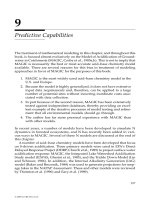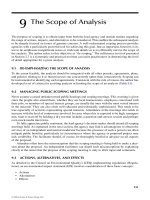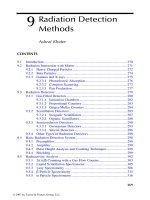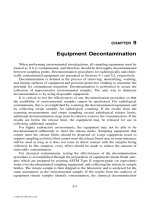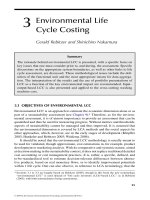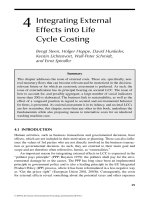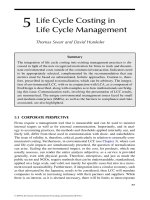Environmental Life Cycle Costing - Chapter 9 pot
Bạn đang xem bản rút gọn của tài liệu. Xem và tải ngay bản đầy đủ của tài liệu tại đây (830.1 KB, 11 trang )
111
CHAPTER
9
Air Pollution — Particulate Matter
9.1 INTRODUCTION
Particulate matter (also called particulates) refers to solid and liquid aerosols
suspended in the atmosphere. These aerosols may vary from 0.5 mm to 10
–7
mm,
and are composed of a large number of inorganic and organic materials, including
metals and nonmetal elements and their oxides, nitrates, and sulfates. Because of
the large quantities of particulates that are emitted into the atmosphere and the
potential adverse effects they elicit, the U.S. EPA has designated particulate matter
(PM) as one of the six “Criteria Air Pollutants” to be regulated. In 1987, the agency
added a new standard for particulates called PM
10
(PM with diameter <10
µ
m),
based on the evidence that smaller PM has the greatest impact on health because of
its capacity to be inhaled. In this chapter, an overview of this class of air pollutants
is presented. This is followed by discussion of three specific examples of PM,
including silica, beryllium, and asbestos.
9.2 CHARACTERISTICS
Particulates are usually classified as primary or secondary. Primary particulates
are larger (usually 1 to 20
µ
m in size) and are emitted directly into the atmosphere
by a variety of chemical and physical processes. Secondary particulates are relatively
smaller and are formed by chemical reactions occurring in the atmosphere.
1
The
composition of particulates varies from place to place and includes thousands of
entities that differ in size, surface, and toxicity.
2
Particles in most urban aerosols
have been shown to contain a number of potentially toxic trace species, such as Pb,
Cd, Ni, Se, V (vanadium), Zn, Br, Co, Mn, sulfate, and benzo[a]pyrene.
3
LA4154/frame/C09 Page 111 Thursday, May 18, 2000 10:32 AM
© 2001 by CRC Press LLC
112 ENVIRONMENTAL TOXICOLOGY
Evidence from recent studies strongly suggests the importance of the primary
urban aerosols. It is considered that, although these primary aerosols contribute
minor amounts of the aerosol mass, they serve as condensation nuclei upon which
the secondary aerosol mass resides, and they carry the bulk of the particulate toxin
and aerosol particles.
4
9.3 FORMATION OF PARTICULATES
Particulates are formed from both natural and anthropogenic sources. Natural
sources include volcanism, forest fires, ocean sprays, and others. A variety of occu-
pational activities involve dust forming, including mining, sand blasting, pottery
making, metal working, and many other crafts. In addition, cultivation of agricultural
lands also contributes significant amounts of PM formation. Mechanism of PM for-
mation includes both physical and chemical processes as shown in the discussion
that follows.
9.3.1 Physical Processes
In general, particles above approximately 1 mm in size are formed by the
disintegration of larger particles. This is called a dispersion process, and the product
is known as dispersion aerosol. Dusts are solid dispersion aerosols, which may be
formed through a variety of natural and human activities. Some examples include:
volcanic eruption, wind-blown dust from dry soil, ocean spray, coal grinding, rock
crushing, stone-cutting and polishing, high-power drilling of tunnel rocks, manufac-
ture of pottery, and others.
9.3.2 Chemical Processes
Both inorganic and organic particles are produced through different chemical
processes. Metal oxides make up a major class of inorganic particles in the atmo-
sphere. They are produced whenever fuels containing metals are burned. For
instance, particulate iron oxide is produced in the combustion of coal, which contains
iron sulfide (FeS
2
) as a contaminant:
3 FeS
2
+ 8 O
2
→
Fe
3
O
4
+ 6 SO
2
(9.1)
As noted in Chapter 8, sulfuric acid mists are formed from the oxidation of
atmospheric SO
2
:
2 SO
2
+ O
2
+ 2 H
2
O
→
2 H
2
SO
4
(liquid droplets) (9.2)
The sulfuric acid thus formed can react with basic air pollutants such as ammonia
or CaO, PbO, or Al
2
O
3
, forming various sulfates:
H
2
SO
4
(droplet) + 2 NH
3
(gas)
→
(NH
4
)
2
SO
4
(droplet) (9.3)
LA4154/frame/C09 Page 112 Thursday, May 18, 2000 10:32 AM
© 2001 by CRC Press LLC
AIR POLLUTION — PARTICULATE MATTER 113
H
2
SO
4
(droplet) + PbO (particle)
→
PbSO
4
(droplet) + H
2
O (9.4)
Combustion of leaded gasoline results in the formation of several kinds of lead
halides, among other substances. Tetraethyl lead in leaded gasoline reacts with O
2
and halogenated scavengers such as dichloroethane and dibromoethane, producing
various forms of lead halide particles that are emitted into the atmosphere:
Pb(C
2
H
5
)
4
+ O
2
+ (halogenated scavengers)
→
CO
2
+ H
2
O + PbCl
2
+ PbBrCl + PbBr
2
(9.5)
Additionally, whole gasoline vapor alone has been shown to significantly contribute
to atmospheric aerosol formation.
5
9.4 TOXICITY
While fly ash particles are generally composed of stable elements or compounds
that are usually not considered directly toxic in concentrations found in ambient air,
subtle toxicity has been recognized under different conditions. In particular, many
trace elements have important biological activity and are, therefore, potential health
hazards. Generally, the toxicity of PM may arise from any of the following factors:
(a) the particles may themselves be toxic, e.g., particles containing toxic metals and
nonmetals such as Pb, Cd, Ni, Hg, and arsenic (As), and radionuclides;
6, 7
(b) they
may adsorb toxic chemicals such as carcinogens,
7,8
and enhance their effect by
increasing their penetration into the lungs, or by prolonging their residence time in
the respiratory tract; (c) they may serve as condensation nuclei for water and other
vapors, producing droplets and enhancing biological effects; and (d) they may, by
virtue of their large quantities in the respired air, overtax the mucociliary apparatus,
thus decreasing the rate of removal of toxic chemicals from the lung.
A variety of occupational activities involve dust forming. Mining, metal grinding,
and sand blasting activities for varying periods of time have been shown to cause
pneumo(no)coniosis
, a disease of the lung caused by habitual inhalation of irritant
mineral or metallic particles. The disease is characterized by fibrous degeneration
known as
fibrosis
. Among the several factors that contribute to the development of
pneumonoconiosis, those related to workers and dust are particularly important. The
factors pertaining to workers include duration of exposure to dust and the workers’
susceptibility. Concerning dust, the sizes of particles, their chemical compositions,
and their concentrations are important. Researchers have identified various diseases
based on the chemical elements involved in fibrosis formation. For example,
silicosis
results from inhalation of SiO
2
;
silicatosis,
from silicate;
siderosis
, from hematite,
Fe
2
O
3
;
talcosis
, from talc;
bariosis
, from barium (Ba), etc. The size of particles is
very important in the pathogenesis of pneumonoconiosis. This is because the size
affects the concentration of particles that may be suspended in the air, or it may
determine the depth to which these particles may penetrate into the lung and the
amounts that may be deposited and retained.
LA4154/frame/C09 Page 113 Thursday, May 18, 2000 10:32 AM
© 2001 by CRC Press LLC
114 ENVIRONMENTAL TOXICOLOGY
In addition to the widely recognized occupational health effects of PM, numerous
epidemiological studies have confirmed that total suspended particles (TSP) present
in urban areas, especially those <2.5
µ
m in diameter, were associated with increased
risk of mortality in pneumonia and cardiovascular disease. The risk is particularly
elevated in the elderly.
6
The limited information available indicates widespread acute
impact on the health of a large number of populations in Indonesia during the
rainforest fire episode in the summer of 1997. According to the Singapore Ministry
of Health, there was a 13% increase in visits to government clinics for acute
respiratory infections and a 19% increase in asthma visits during the last week of
September when PM levels peaked.
9
9.5 SILICA
Silica (silicon dioxide, SiO
2
) and silicates constitute the major portion of all
rocks and their products, such as soils, sands, and clays. Silicon (Si) is the second
most abundant element (after oxygen) in the Earth’s crust. Silica occurs in either its
free form or a combined state called a
silicate
. Free silica may be in crystalline form
such as quartz, granite, flint, and diatomite, or in noncrystalline form.
9.5.1 Silicosis
Silicosis
is a disease caused by breathing tiny particles of free SiO
2
. It is considered
the most important of the pneumoconioses, or dust diseases of the lung, not only
because of its serious damaging effect on the respiratory system but also because of
the large numbers of workers throughout the world who are at risk of contracting it.
Silicosis may be acute, because the disease is manifested within 8 to 18 months
following the first exposure. Chronic silicosis may develop with a latency period up
to 20 years and is found among people engaged in mining industries, pottery manu-
facture, stone cutting and polishing, tile and clay production, and glass manufacture.
Silicosis increases susceptibility to various respiratory infections, notably tuberculosis.
The size of offending silica particles is extremely important in determining the
degree of tissue reaction that will occur following the inhalation of the siliceous dust.
Particles of silica or silicate from 0.5 to 10
µ
m are responsible for the disease, because
they lead to fibrogenic reaction in alveolar tissue. Fibrous, or scar, tissue is formed
to replace the normal lung tissue, but the fibrous tissue does not have the elasticity
of normal tissue and handicaps the lung in performing its ventilatory function and
the exchange of gases between the air and blood. As a result, the victim becomes
short of breath, a principal clinical characteristic of silicosis. Occupational exposure
to respirable crystalline free silica can occur among workers involved in mining, stone
cutting, abrasive blasting, ceramics, refractory and boiler work, and other occupations.
9.5.2 Pathogenesis
Many hypotheses have been advanced to explain the mode of action of silica
pertaining to its fibrogenic properties. For many years researchers thought the fib-
LA4154/frame/C09 Page 114 Thursday, May 18, 2000 10:32 AM
© 2001 by CRC Press LLC
AIR POLLUTION — PARTICULATE MATTER 115
rogenic properties were due to the action of silicic aid. However, Allison et al.
10
suggested that the intracellular reaction to silicic acid is the first of a two-stage
process in which the major fibrogenic stimulus comes from the action of cellular
enzymes rather than directly from silicic acid itself. According to their hypothesis,
once a silica particle is arrested in the lungs, it is invaginated, initiating phagocytosis.
The particle is encapsulated within the cell in a phagosome that soon becomes
converted into a second type of lysosome (digestive vacuole) through merging with
primary lysosome presumably secreted by the Golgi body. Protective substances
adsorbed onto the silica particles (e.g., plasma proteins) are stripped off by the
enzymes released from the lysosome, exposing silicic acid (H
4
SiO
4
). The highly
reactive silicic acid acts as a hydrogen donor to form hydrogen-bonded complexes
with active groups of the lipid membrane, such as phosphate ester groups, and with
secondary amide (peptide) groups of proteins. This reaction causes the lysosomal
membrane to become permeable, allowing its enzymes to leak into the cytoplasm
and destroy the cell. With cellular dissolution, the cell contents, including active
lysosomal enzymes, along with the ingested silica, are released into the tissue
interstices (Figure 9.1). Moreover, the freed particles of silica are again phagocytosed
by other macrophages, resulting in a chain of events.
9.6 BERYLLIUM
Beryllium (Be) is one of the least known environmental pollutants and yet it is
one of the most toxic nonradioactive elements known. Its industrial Threshold Limit
Value (TLV) is 2 mg/m
3
, the lowest of all particulates. (The TLV of a toxicant is
defined as the maximum concentration to which it is believed healthy workers may
be repeatedly exposed without ill effect, on the basis of an 8-h working day.) The
toxicity of Be disease in humans was described in the U.S. in the 1940s, when more
than 500 cases were reported. Acute disease occurred in Ohio among Be extraction
and production workers, while chronic disease was found in Massachusetts among
workers manufacturing fluorescent lamps containing beryllium-phosphor. The use
of Be in fluorescent lamps was discontinued in 1950. As a result, Be disease
incidence has decreased dramatically.
Beryllium is estimated to comprise about 0.0006% of Earth’s igneous rocks. Of
28 minerals in which Be is a minor accessory constituent, only
beryl
or beryllium
aluminum silicate (Be
3
Al
2
Si
6
O
18
), with 14% BeO, is the chief source of Be and as
such is the most important commercially. Beryllium is also found in coal in amounts
ranging from 0.1 to 1000 ppm.
9.6.1 Sources of Exposure
Exposure to Be compounds can occur within the production and manufacturing
industries as well as in housekeeping, maintenance, salvage, and solid waste areas.
Individuals working in all operations involving production of airborne Be are at risk
for developing Be disease. Major occupations at risk for developing Be disease have
changed since the first reports of cases in the U.S. in the 1940s. Before 1950, common
LA4154/frame/C09 Page 115 Thursday, May 18, 2000 10:32 AM
© 2001 by CRC Press LLC
116 ENVIRONMENTAL TOXICOLOGY
Figure 9.1
Suggested mechanism of silicosis. (Adapted from Hopps, H.C., Carlisle, E.M.,
McKeague, J.A., Siever, R., and Van Soest, P.J., Silicon, in: NRC,
Geochemistry
and the Environment, Vol. II The Relation of Other Selected Trace Elements to
Health and Disease,
National Academy of Sciences, Washington, D.C., 1977, 67.
Invagination
leading to
phagocytosis
Cell
cytoplasm
Silica particle
Phagosome
Golgi
body
Primary
lyso-
some
E.R.
Phagosome
lysosome
Digestive
vacuole
Residual
body
Disruption of
cell with release
of digestive enzymes
and SILICA
LA4154/frame/C09 Page 116 Thursday, May 18, 2000 10:32 AM
© 2001 by CRC Press LLC
AIR POLLUTION — PARTICULATE MATTER 117
exposure occurred in fluorescent lamp manufacturing, atomic bomb research, and
Be extraction operations. After 1950, Be was replaced by a calcium phosphor in
fluorescent lamp production. However, Be has since been used in modern technology,
including in nuclear reactors and electronics equipment, guidance and navigation
systems, rocket parts, and heat shields. It is employed extensively as an alloying
agent for copper, since it adds tensile strength, conductivity, and corrosion resistance.
Chronic Be disease has been reported in people living in areas adjacent to a
plant or industry using the metal, suggesting neighborhood exposure from plant
discharges into the air. It has also been shown that families of Be workers may also
be exposed to the metal as a result of dust carried home on the workers’ clothes.
Between 1973 and 1980, 66 cases were reported in the United States. Nearly half
of these were involved in Be metal production. The combustion of coal is considered
the largest source of environmental Be contamination. Some coal contains about 2.5
ppm, and oil contains about 0.8 ppm Be. Atmospheric emission of Be from these
sources was estimated to be above 1000 metric tons annually.
11
9.6.2 Health Effects
Chronic Be disease, commonly known as berylliosis, is manifested by pulmonary
and systemic granulomatous disease caused by exposure to Be by inhalation. The
duration of exposure may be from several months to years. The interval between
initial exposure and clinical manifestations of disease varies with individuals. Some
patients may not become symptomatic until up to 25 years after their last exposure.
The average latency is 10 to 15 years. The most common symptom of chronic Be
disease is dyspnea (shortness of breath). Other symptoms include cough, fatigue,
weight loss, chest pain, signs of pulmonary hypertension, nodular skin lesions,
conjunctivitis, and others.
In acute disease, nasopharyngitis, tracheobronchitis, or chemical pneumonitis
may occur, resulting in edema, inflammation, and necrosis. The severity of clinical
disease depends largely on the dose of Be exposure. Symptoms and signs are
nonspecific, identical to those found in any case of chemical pneumonitis secondary
to a lung irritant, and include dyspnea, cough, chest pain, blood-tinged sputum, and
cyanosis. Acute Be disease is currently uncommon. Evidence from both animal
experiments and human epidemiologic findings suggests a link between Be and lung
cancer in humans.
9.6.3 Biochemical Effect
In animal studies, Be has been shown to cause ultrastructural changes in liver.
Alterations include vacuolization and dense deposits in lysosomes, loss of fibrils
and appearance of dense plaques in some nucleoli, and distortion of bile canaliculi.
12
Changes in lysosomal morphology were found to correlate with the biochemical
evidence of localization of Be within lysosomes. Increases in serum gammaglobu-
lins, elevated erythrocyte sedimentation rate, and erythrocytosis, hyperuricemia, and
transient hypercalcemia and hypercalciuria have also been noted.
LA4154/frame/C09 Page 117 Thursday, May 18, 2000 10:32 AM
© 2001 by CRC Press LLC
118 ENVIRONMENTAL TOXICOLOGY
Beryllium affects the enzyme that leads to DNA synthesis. Beryllium can act as
a competitive inhibitor of Mg
2+
, cofactor for DNA polymerase. DNA polymerase
catalyzes the formation of a polynucleotide from a single DNA template strand and
a short complementary DNA or RNA primer. It also functions to “proofread” the
base pairing as a new strand of DNA is formed. In this way, it can remove an
incorrectly base-paired nucleotide before the next nucleotide is added to the DNA
strand. Therefore, when Be competitively inhibits Mg
2+
, a base-substitution mutation
may occur. In addition, it has been reported that the physical properties of DNA are
affected by 0.1 to 1 m
M
BeSO
4
.
9.6.4 Therapy
One of the remedies for berylliosis is the use of chelating agents, such as
aurintricarboxylic acid (ATA) (Figure 9.2A). In an experiment conducted earlier,
researchers injected mice with enough Be salt to kill them within a few days. Half
of the animals were injected with a small quantity of ATA and the other half were
left untreated. The results showed that virtually every animal treated with ATA
survived and lived on normally, whereas all the untreated animals died. The exper-
iments were repeated with hundreds of animals of different species, with the same
high degree of protection. Subsequent studies using radioactive Be and ATA showed
that the chelating agent was found in practically every cell where Be was present.
Previously damaged cells recovered, and within a few days they could not be
distinguished from the normal tissue cells. How ATA functions chemically to antag-
onize Be is incompletely understood. A suggested mechanism involved in the chelate
is shown in Figure 9.2B.
9.7 ASBESTOS
Asbestos is a generic term for a number of hydrated silicates that, when crushed
or processed, separate into flexible fibers made up of fibrils.
13
Asbestos is mined
primarily from open pits. The annual consumption of asbestos in the U.S. peaked
at about 800,000 tons in 1973, but by 1984 it declined to slightly above 200,000
tons, mainly because of concerns about its toxicity.
14
9.7.1 Chemical and Physical Properties
Asbestos fibers occur in basic shapes, i.e., amphibole and serpentine, both being
hydrated magnesium silicates. The theoretical formulas for amphibole and serpentine
or chrysotile are Mg
6
Si
4
O
10
(OH)
8
and 3MgO · 2SiO
2
· 2H
2
O · H
2
O, respectively.
Physical properties resulting in widespread use of asbestos include (a) insulation
against heat, cold, and noise; (b) incombustibility; (c) good dielectric properties; (d)
flexibility; (e) great tensile strength; (f) resistance to corrosion by alkalis and most
acids; and (g) ease with which it spins (for some asbestos such as chrysotile).
LA4154/frame/C09 Page 118 Thursday, May 18, 2000 10:32 AM
© 2001 by CRC Press LLC
AIR POLLUTION — PARTICULATE MATTER 119
9.7.2 Uses
It is estimated that asbestos has about 3000 uses. It was estimated earlier that
in the U.S. more than 200,000 miles of asbestos-cement pipes carrying drinking
water and other materials were in place. Main uses of asbestos include brake linings
and clutch facings; filters, gaskets, and friction material; yarn, thread, rope, cloth,
and other textiles; steam and fire hoses; wall, floor, and roofing tile; electrical
insulation; gas mask filters; and paints and fillers.
9.7.3 Exposure
In the U.S., an estimated 37,000 persons were said to be employed in the manu-
facture of primary asbestos products, while 300,000 persons were in secondary asbes-
tos industries. Several million persons may be exposed to asbestos in consumer indus-
tries, such as brake repair and shipyards. Indeed, asbestos is a ubiquitous contaminant
of our industrialized society and is found in urban air, drinking water, and inside high-
rise office buildings. Asbestos has been detected within the Greenland ice sheet.
Asbestos bodies were found in 48.3% of lungs of 3000 consecutive autopsies
from three hospitals in New York. Similar observations were made in other big
cities. In addition to the lungs, other organs, such as the thyroid, spleen, pancreas,
Figure 9.2
(A) Chemical structure of aurintricarboxylic acid (ATA); (B) Suggested mechanism
whereby Be is chelated by ATA.
+22&
+2
&22+
2+
&22+
2&
2
2
2
%H
2
2
2
(A)
(B)
LA4154/frame/C09 Page 119 Thursday, May 18, 2000 10:32 AM
© 2001 by CRC Press LLC
120 ENVIRONMENTAL TOXICOLOGY
heart, adrenals, kidney, prostate, brain, and liver, have also been shown to contain
some asbestos.
9.7.4 Pathogenicity in Humans
Health problems related to exposure to asbestos were recognized by the early
1900s. It was recognized in the 1950s and 1960s that asbestos was responsible for
lung and pleural tumors in asbestos miners.
15
The effects of asbestos fibers on
biological systems may result not only from the properties of the fibers themselves,
but also from contamination with inorganic or organic substances that occur naturally
or are added during mining, milling, processing, or shipping. The proven or suspected
effects of asbestos minerals on human health include nonmalignant changes, such
as pulmonary and pleural fibrosis, and several types of malignancy, especially of
the lung, pleura, and peritoneum. Association between asbestos and human disease
was revealed from studies on certain occupational groups, notably workers engaged
in the mining and milling of asbestos, the manufacture of asbestos-containing prod-
ucts, and the application and removal of asbestos-containing insulating materials.
Asbestosis
(or
asbestotic pneumoconiosis
) may develop after years of intense
exposure and was the first clearly demonstrated adverse effect of asbestos in humans.
The condition is characterized by lung fibrosis or scarring of the lungs. Victims
become short of breath and may eventually struggle so hard to breathe that they die
of heart failure. Some researchers have suggested that from about 1950 to 1975,
approximately 10% of the deaths among New York City insulation workers were
caused by asbestosis. Pulmonary fibrosis sufficient to interfere with respiratory or
cardiovascular function can be prevented by reducing asbestos dust concentration
to levels that are still far above any likely to be encountered in community air.
Calcified pleural plaques occur frequently in workers exposed to asbestos. When
multiple or bilateral, they are regarded by some as almost diagnostic of asbestos-
related disease. Epidemiological studies have shown that occupational exposure to
asbestos can also produce lung cancer, which may occur after a latency period of
10 to 30 years. As mentioned in Chapter 4, there is synergism between cigarette
smoking and asbestos exposure in relation to lung cancer development.
It is widely recognized that the problems associated with asbestos still exist,
although they have greatly decreased in the U.S. The health problems associated
with asbestos exposure are well known and widely recognized. As a result, occupa-
tional standards have become more stringent, and testing methods are sophisticated.
With improvement in remediation methods and the availability of more information
about how asbestos fibers cause health problems in humans, the threat of asbestos
to humans should continue to diminish.
9.8 REFERENCES AND SUGGESTED READINGS
1. Fennelly, P.F., The origin and influence of airborne particulates,
Amer. Sci
., 64, 46,
1976.
2. Abelson, P.H., Airborne particulate matter.
Science,
281, 1609, 1998.
LA4154/frame/C09 Page 120 Thursday, May 18, 2000 10:32 AM
© 2001 by CRC Press LLC
AIR POLLUTION — PARTICULATE MATTER 121
3. Natusch, D.F.S. and Wallace, J.R., Urban aerosol toxicity: the influence of particle
size,
Science,
186, 695, 1974.
4. Ondov, J.W. and Wexler, A.S., Where do particulate toxins reside? An improved
paradigm for the structure and dynamics of the urban mid-Atlantic aerosol,
Environ.
Sci. Technol
., 32, 2547, 1998.
5. Odum, J.R. et al., The atmospheric aerosol-forming potential of whole gasoline vapor,
Science
, 276, 96, 1997.
6. Costa, M. and Mollenhauer, H.H., Carcinogenic activity of particulate nickel com-
pounds is proportional to their cellular uptake,
Science
, 209, 515, 1980.
7. Hauser, R. et al., Upper airway response to workers exposed to fuel oil ash: nasal
lavage analysis,
Occup. Environ. Med
., 52, 353, 1995.
8. Schwartz, J., Total suspended particulate matter and daily mortality in Cincinnati, Ohio
,
Environ. Health Persp.
, 102, 186, 1994.
9. Brauer, M. and Hisham-Hashim, J., Fires in Indonesia: crisis and reaction,
Environ.
Sci. Technol./News
., September 1, 1998, 404A.
10. Allison, A.C., Harington, J.S., and Birbeck, M., An examination of the cytotoxic
effects of silica on macrophages, J. Exp. Med., 124, 141, 1966.
11. Goyer, R.A., in Casarett and Doull’s Toxicology: The Basic Science of Poisons,
Klaassen, C.D., Amdur, M.O., and Doull, J., Eds., Macmillan Publ. Co., New York,
1986, 582.
12. Goldblatt, P.J., Beryllium-induced ultrastructural changes in intact and regenerating
liver, Arch. Environ. Health, 26, 48, 1973.
13. Gaze, R., The physical and molecular structure of asbestos, Ann. N.Y. Acad. Sci., 132,
23, 1965.
14. Zurer, P.S., Asbestos. Chem. & Engn. News, March 4, 24, 1985.
15. Mosman, B.T. et al., Asbestos: scientific developments and implications for public
policy, Science, 247, 294, 1989.
9.9 REVIEW QUESTIONS
1. Define (a) primary, and (b) secondary particulates.
2. Explain the characteristics of particulate matter.
3. Why is size particularly important in determining the toxicity of particulate
matter?
4. What are some of the natural sources of particulate matter? And, anthropo-
genic sources?
5. Explain the importance of H
2
SO
4
as particulate matter.
6. Explain the reasons for the toxicity of particulate matter.
7. What is pneumo(no)coniosis?
8. What is silicosis? Why is silicosis important in public health/toxicology?
9. Explain the current understanding of the mode of action for silicosis.
10. Explain why combustion of coal is considered the largest source of environ-
mental Be contamination.
11. How is Be related to DNA?
12. What is ATA? Explain how it may help alleviate Be toxicity.
13. List the health effects of asbestos.
14. How are smoking and asbestos exposure related?
LA4154/frame/C09 Page 121 Thursday, May 18, 2000 10:32 AM
© 2001 by CRC Press LLC
